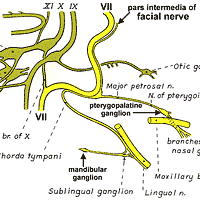| Home Page |
General ANS Features |
Sympathetic Division |
Parasympathetic Division |
Trace Pathways |
Physiology & Pharmacology |
Parasympathetic Path to Nasal & Lacrimal Glands
|
Origin:
parasympathetic nucleus of the facial nerve Preganglionic Pathway: facial nerve (pars intermedia), major petrosal nerve, nerve of ptyerygoid canal Ganglion: pterygopalatine ganglion Postganglionic Pathway: branches to lacrimal & nasal glands Target Organs: lacrimal gland & nasal cavity glands |

|
Parasympathetic Path to Ventral Salivary Glands
 |
Origin:
parasympathetic nucleus of the facial nerve Preganglionic Pathway: facial nerve (pars intermedia), chorda tympani nerve (travels through the middle ear), lingual nerve, lingual nerve branch to salivary glands Ganglion: mandibular ganglion (also a sublingual ganglion) Postganglionic Pathway: branches to mandibular & sublingual salivary glands Target Organs: mandibular salivary gland & sublingual salivary glands (monostomatic and polystomatic sublingual glands) |
Textbook Images (click to view enlarged) Left. Within the temporal bone, preganglionic parasympathetic fibers leave the facial nerve to synapse in pterygoplatine and mandibular ganglia. Right. The pterygoplatine ganglion is located beside the maxillary nerve on the medial pterygoid muscles. Postganglionic branches from the ganglion innervate lacrimal and nasal glands. |
 |
 |
Go Top
